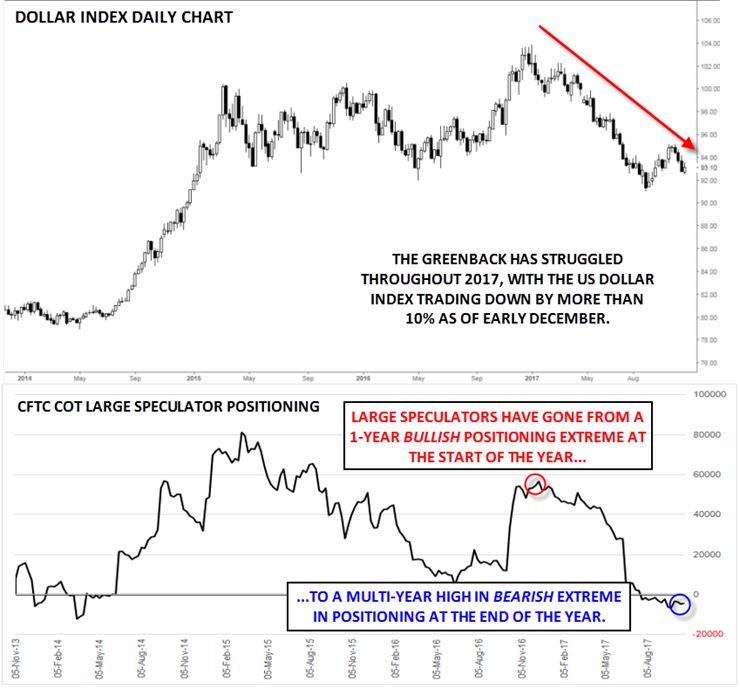There are no two ways about it: 2017 has been a brutal year for US dollar bulls.
As of writing, the world's reserve currency has fallen against every one of its major rivals on the year, losing a staggering 12% against the euro and over 8% versus the British pound. Incredibly, this move has occurred despite the Federal Reserve being inarguably the most hawkish of the major central banks, hiking interest rates three times while many of its rivals remained on hold.
So what drove the dollar lower throughout the year? The same thing that always moves markets: an imbalance between buyers and sellers.
It seems like a lifetime ago, but recall that as the calendar flipped to 2017, hopes were running high that "Businessman President" Donald Trump would unlock the growth potential of the US economy through a combination of cutting taxes and reducing burdensome regulations. With the help of a Republican-controlled Senate and House of Representatives, traders' expectations for a pro-business agenda spawned a surge in the greenback and US stocks (the so-called "Trump Trade").
This view was reflected in the CFTC's Commitment of Trader (COT) data, which showed that speculative futures traders were holding net long positions in the US Dollar Index to the tune of over 54,000 contracts at the start of the 2017, essentially the highest net long position in over a year. As President Trump struggled to enact his legislative agenda and the US economy encountered some hurdles, the optimism bubble gradually deflated, and the US dollar fell consistently throughout the first three quarters of the year.
Now, we're presented with the mirror image scenario from the start of last year: expectations are low that Republicans on Capitol Hill will be able to get any legislation signed, and dollar index traders are now positioned net short over 4,000 contracts, the most bearish reading since mid-2014. In other words, the pendulum of market sentiment has shifted from extreme bullishness with high expectations to extreme bearishness with low expectations, potentially setting the dollar up for a far better year in 2018 than 2017.
Meanwhile, there's a hawkish shift afoot at the Federal Reserve next year. Incoming Fed Chair Jerome Powell is unlikely to diverge much from his predecessor Janet Yellen's cautious outlook, but the annual rotation in voting members definitively favors the hawks. Some of the most dovish voters in 2017, including Chicago Fed President Charles Evans and Minneapolis Fed President Neel Kashkari, will go back to the proverbial bench, making way for two Fed Presidents who have shown hawkish tendencies in the past, Loretta Mester (Cleveland) and John Williams (San Francisco). If inflation finally shows signs of perking up in 2018, this group of central bankers won't hesitate to raise interest rates aggressively to try to ensure the Fed doesn't fall "behind the curve."
With US dollar bulls as downbeat on the prospects for the world reserve currency as they've been in years, the bar is low for positive economic surprises. Even if the US economy doesn't show signs of accelerating in 2018, buck bears could struggle to push the currency lower given the already-lopsided positioning, especially against currencies that speculators have accumulated heavy long positions in, including the euro, Aussie, and loonie.
There's no doubt that buying the greenback requires a leap of faith, but as experienced contrarian traders know, the positions that feel the worst at the start often end up working out the best. After all, the night is darkest just before the dawn.

